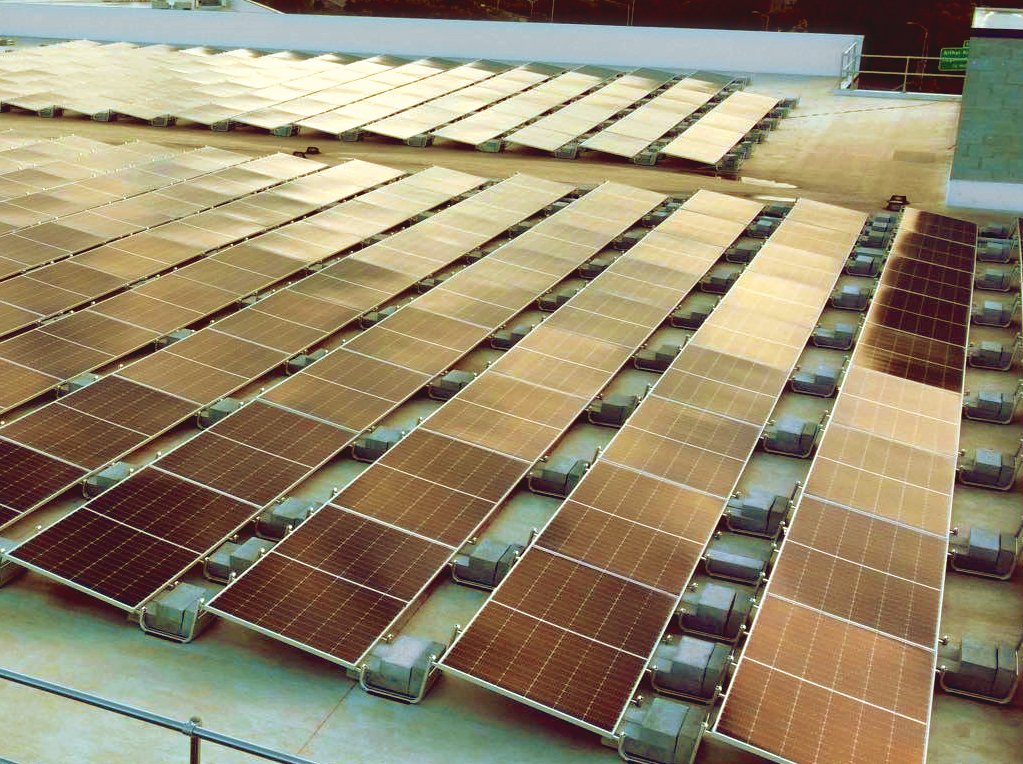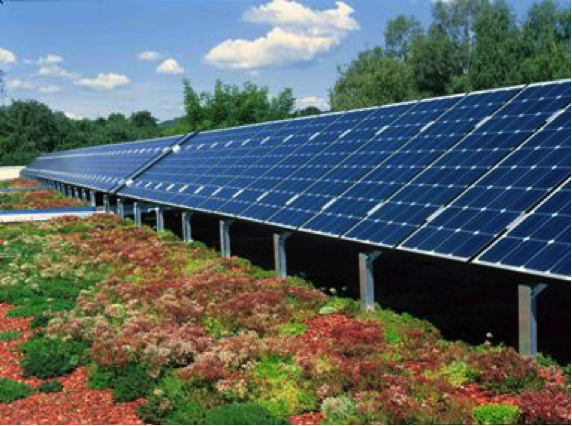Integrated Solar Green Roofs Are For The Greedy
By Alan Burchell and Jessica Greenspan
Rooftop solar photovoltaic (PV) systems and green rooftop gardens are two environmentally-friendly technologies that have experienced a steady rise in popularity in recent years. A common misconception is that they are mutually exclusive concepts, competitors for both rooftop space and photons. However, with Urbanstrong’s Solar Green Roofs, not only can these two competitors co-exist, but the two technologies actually work together synergistically to boost each other’s performance. In the warmer summer months, this can mean up to a 6-12% boost in electricity production over traditional rooftop solar. Below, we’ll first introduce the systems and then explore this positive symbiosis.
What does a standard rooftop solar PV install look like?
We’ve all seen your standard rooftop solar PV installation: a few rows of tilted PV cells aimed toward the sun, converting sunlight into useful electricity. With all the financial incentives available in NYC, solar systems here can pay for themselves in as little as two years.
What is a green roof?
Green roofs, a bit less familiar than solar panels, are roofs covered completely or partially with vegetation. Green roofs protect roof membranes, while enabling flora to grow through an integrated root, drainage, and soil system. They reduce energy bills, boost property values and are attractive to customers and investors. Green roofs can differ significantly in style, function, and price to match goals, budgets and design constraints.
Physically integrating solar PV and green roofs
With such incredible benefits from each technology individually, why not integrate the two to amplify and broaden those benefits? To that end, Urbanstrong offers an integrated Solar Green Roof product, transforming roofs into productive lush gardens that generate a passive income for owners.
How does it work? The magic of this system really comes down to the base of the Solar Green Roof mounting system, as it simultaneously performs two key functions. Firstly, it serves as the green roof system’s drainage board, storing a fixed amount of water for the plants above and carrying away the excess. Then, being buried below the keeps it weighed down and allows it to act as a stable base to which the solar panels can then be securely mounted. This eliminates the need for penetrating anchor points or traditional ballast blocks used in standard rooftop solar systems.
Note: Solar panels need to be weighed down to ensure they don’t blow away. Rest assured, Urbanstrong’s Solar Green Roof was carefully tested in German wind tunnels with great success. And if that’s not enough, our installation on the NYC Parks Department Building roof on Randall’s Island stood up to Superstorm Sandy without moving an inch.
Urbanstrong Solar Green Roof on NYC Parks Department Building
Green roof plants boost solar PV panel performance
If on a hot day, you’d rather head to the park to read a book than lay down on a black tar lot, then you already intuitively know the answer to this question. Like many other consumer electronics, solar panels lose efficiency when they get too hot. The rate at which this occurs is called the Temperature Performance Coefficient. This rating can be found on each panel model’s technical specifications data sheet.
Basically, for every degree above 77°F/25°C that the surrounding air climbs, the panel produces slightly less electricity. Ask any roofer, and they’ll tell you that on a day where it’s 90°F at street level, it can reach up to 160°F on the roof. This means that a typical rooftop PV array on an asphalt roof may fall 12-25% below the nameplate rating in higher temperatures. Many cities, like New York, suffer from the urban heat island effect caused by the concentration of dark surfaces like roads and roofs. This compounds the already high temperatures in our long, steamy summers. Imagine all that loss in electricity production.
Cutaway Assembly of Urbanstrong’s Solar-Integrated Green Roof with Standard Stormwater Assembly
During evapotranspiration, when plants ‘sweat out’ their water vapor, they can, for example, cool the air around them (and their integrated solar panel) from 150°F down to 100°F. This cooler air prevents the panels from overheating (and losing efficiency), thereby effectively boosting the panels’ electricity production by anywhere from 6-12% in the warmer summer months. Compounded over the 25 year rated lifespan of a solar panel, this performance boost can dramatically affect the payback of your solar PV system.
Other benefits of integrated solar green roofs
Increased efficacy is just one of the many benefits of Solar Green Roofs. Plants scrub the air and prevent dust build-up on panels, which can otherwise impede electricity production. The system is typically eligible for financial incentives for both solar and green roofs. Where allowed by building code, the weight of the green roof materials can act as the ballast for the solar system thereby eliminating the need for roof membrane penetrations. Also, the greenery improves the overall aesthetics of the solar array which is nice if it can be seen from units above or nearby amenity decking on the roof. Further, the shading created by tilted solar panels provides space for shade-seeking plant species to thrive, increasing biodiversity and green roof system health.
Business as usual
The individual benefits of both systems still apply as well. For solar PV: cutting back on electricity bills and achieving energy freedom. Or owners can sell the electricity at a premium into a scheme like NYC’s Community Solar program for a steady, passive income.
For green roofs: protection of the otherwise bare roof membrane from UV degradation for reduced roof maintenance/replacement, thermal insulation, noise muffling, stormwater management, and access to nature. Both technologies increase property values. Further, with a Solar Green Roof, one can earn a generous number of LEED and WELL building standard credits.
Green roof plant species selection
Of course, one should pay careful attention to plant selection so as not to inhibit the panels’ electricity production. Plants that grow too tall may shade the panels. The pollen from flowering plants may result in optical losses. Ideally, one should plant shade-seeking or shade-tolerant species underneath the panels.
Examples of integrated solar green roofs from around the world
Viborg Town Hall
The new town hall building in Viborg, Denmark contributes to the building’s impressive environmental standards, while staying true to the artistic culture of the region.
School roof in Unterensinge
A school roof in Unterensinge. Germany has the largest concentration of solar green roofs in the world.
Solar Outpost at Vice
This free-standing, energy-independent installation elevates the concept of Solar Green Roofs by adding a workspace amenity.
Conclusion
In conclusion…stop wasting your roof! Solar Green Roofs provide ample opportunity to get creative in how you maximize the utility of your building. For a better idea of how Urbanstrong tackles their solar green roofs, please click here.









